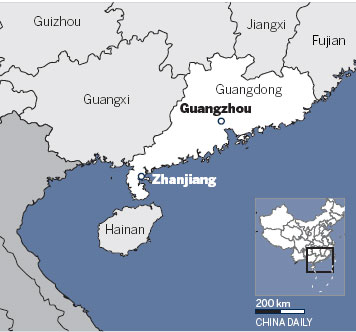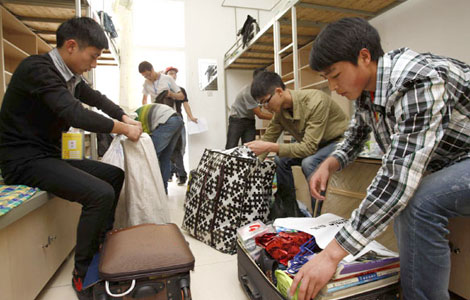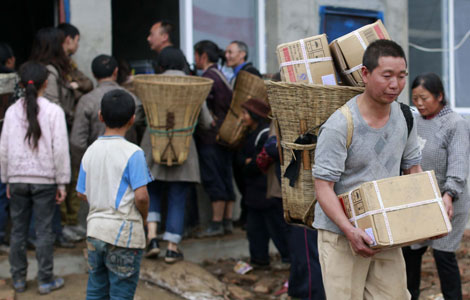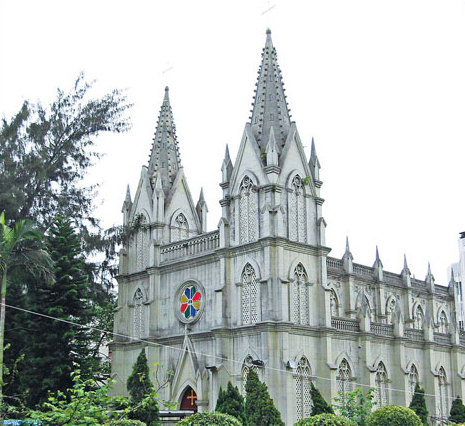Uncovering a city's past
Updated: 2013-04-25 05:42
By Li Wenfang (China Daily)
|
||||||||
|
A Catholic church, built in 1902, remains in use in Zhanjiang, as an example of the city's colonial-era architecture. Zou Zhongpin / China Daily |
Guangzhouwan, a former treaty port in Guangdong province, features early 20th-century French architecture that tells of its storied past. Li Wenfang takes a closer look.
Researching the history of Guangzhouwan during its French occupation can easily provide material for a hundred doctorate degrees. At least this is what He Jie, a local journalist and head of the society being built on such research, believes.
Guangzhouwan once referred to an area made up of a few villages on Guangdong province's Nansan Island. It is now part of the city of Zhan-jiang, located in the southwestern part of the province.
The name Guangzhouwan, also spelled Kwangchowan, was adopted when 518 sq km of land and some of its surrounding sea, was leased by the Qing Dynasty (1644-1911) to France in 1899. In 1943, it was occupied by Japan, and two years later returned to China, after which it was renamed Zhanjiang.
Guangzhouwan's colonial history has been largely "covered in dust" and deserves attention from Chinese scholars, He says.
Previous Chinese studies on Guangzhouwan merely focused on the Chinese resistance to French invaders, says Ye Caiping, former deputy curator of the Zhanjiang Museum.
Guangzhouwan became a duty-free port in 1912. The French designed it to counter the growing power of neighboring Hong Kong, then under British rule, He says.
Its once vibrant foreign trade - reaching a peak of 160 million francs in 1916, as a French general put it in his memoir - is only the tip of Guangzhouwan history's iceberg.
After the War of Resistance against Japanese Aggression broke out in 1937, it remained the only free port connecting China with the rest of the world, and its business thrived.
Wen Yiduo, a contemporary Chinese poet, included Guangzhouwan in his famous poem Songs of Seven Sons. Written in 1925, the poetry talked about the seven places along the Chinese coast ceded to foreign powers and how the Chinese longed for their return to the motherland.
But at the same time, people realized foreign occupation also brought new ideas into China.
"The French leasing Guangzhouwan was indeed an act of invasion, which deserved the resistance of our nationals. But they also brought in Western culture, which deeply influenced the lives of people living in the leased area," Zhu Yu, a former director of Zhanjiang's bureau of culture, wrote in his preface to a book on contemporary buildings in Zhanjiang, published last year.
Zhu mentioned Guangzhouwan's hospital built in 1922, as well as its first power plant, constructed in 1927.
"A city without history is pitiable. Buildings record the history of a city, show historical development and witness social development," he wrote.
"Through buildings, the elderly recollect past lives, while the young get to know history to better steer the future."
Many books and papers on Guangzhouwan can be found in libraries in France, but translating them will be a mammoth task, Ye says.
A visitor to Zhanjiang, however, can still see traces of its colonial past.
The administrative offices of Guangzhouwan's former French rulers, on Haibin Road, is one of only seven remaining French colonial structures in urban Zhanjiang due to the city' rapid infrastructure development, Ye says.
Designed in the French neoclassical style, the building was constructed in 1903. It became a provincial culturally protected relic in 2002 and now regularly serves as a venue for art exhibitions.
In the 1980s, Zhu almost lost his government post when he advocated for the building's protection.
Three minutes away on foot, along Yan'an Road, is the building that used to house the French police department. Also built in 1903, it is now a district sub-station of the public security bureau.
The Catholic church, completed in 1902, still stands on Lyuyin Road and remains in use.
The former Bank of Indochina, the first contemporary bank in Guangzhouwan, built in 1926, has been used by the Zhanjiang branch of the Industrial and Commercial Bank of China since 1984.
The Chamber of Commerce of Guangzhouwan was the largest business chamber of its time in western Guangdong. It consisted of 30 industrial chambers, such as those for department stores, shipping and textiles.
Its building, in the French classical style, was completed in 1925 and is located on Minzhu Road.
A lighthouse was built on Naozhou Island in 1900 to guide French military ships and commercial vessels. It's now one of only two crystal-mirror lighthouses still in use around the world.
The 1920s and 1940s saw the construction of many public, industrial, commercial and residential buildings that combined Chinese and Western architectural elements.
Some can still be seen around Zhanjiang, especially in Chikan district.
The city government is now resolved to protect and renovate the former French concession's architecture.
And to boost tourism, it plans to turn the area with many French buildings into a "French street".
The first phase of the project is scheduled to wrap up in September.
Contact the writer at liwenfang@chinadaily.com.cn.

(China Daily 04/25/2013 page19)

 'Taken 2' grabs movie box office crown
'Taken 2' grabs movie box office crown
 Rihanna's 'Diamonds' tops UK pop chart
Rihanna's 'Diamonds' tops UK pop chart
 Fans get look at vintage Rolling Stones
Fans get look at vintage Rolling Stones
 Celebrities attend Power of Women event
Celebrities attend Power of Women event
 Ang Lee breaks 'every rule' to make unlikely new Life of Pi film
Ang Lee breaks 'every rule' to make unlikely new Life of Pi film
 Rihanna almost thrown out of nightclub
Rihanna almost thrown out of nightclub
 'Dark Knight' wins weekend box office
'Dark Knight' wins weekend box office
 'Total Recall' stars gather in Beverly Hills
'Total Recall' stars gather in Beverly Hills
Most Viewed
Editor's Picks

|

|

|

|

|

|
Today's Top News
Phone bookings for taxis in Beijing
Chinese consumers push US exports higher
Seoul delivers ultimatum to DPRK
Boston bombing suspects intended to attack NYC
No let up in home price rises
Bird-watchers undaunted by H7N9 virus
Onset of flood season adds to quake zone risks
Vice-president Li meets US diplomat
US Weekly

|

|







